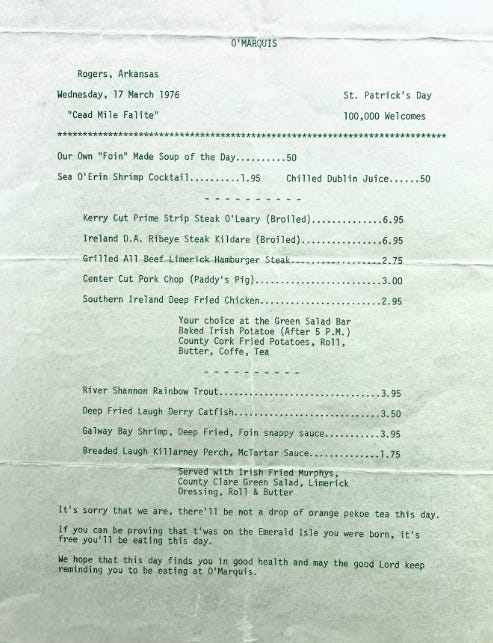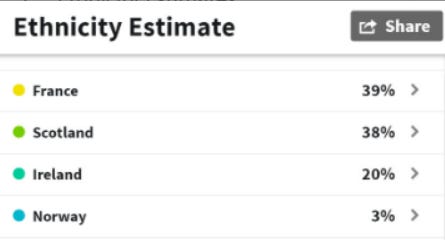Erin Go Braugh!
A symbol of a heritage I know too little about but respect and honor, nevertheless
When I was a kid, I had a small Irish flag that hung from my knick-knack shelf in the corner of my bedroom. The phrase Erin Go Braugh was stitched into the cheap green nylon fabric. I don’t remember if it had an image on it, but it probably did. When I looked for Erin Go Braugh flags online, they all seem to include the side silhouette of a woman with wings stretched back over harp strings, hair in a bun, and a small breast protruding from her chest. She’s standing in elegantly curved patterns that could be interpreted as waves.
When I researched the history of this flag, I learned that the Erin Go Bragh flag has deep roots in Irish history, symbolism, and identity. The slogan, from the Gaelic phrase Éirinn go Brách, meaning "Ireland Forever," emerged prominently during Ireland’s 1798 rebellion against British rule as a rallying cry for independence and solidarity, not long after our own fight for independence.
Throughout the 19th century, the flag and phrase became symbols of national pride and unity, especially among the Irish diaspora, notably appearing in the banners of Irish-American military units during the Mexican-American War and the American Civil War.
In the early 20th century, amid Ireland’s renewed fight for independence during the Easter Rising (1916) and subsequent War of Independence, the Erin Go Bragh flag again gained prominence, reinforcing its status as a powerful emblem of resistance, perseverance, and national pride. Today, it continues as a cherished symbol of Irish heritage worldwide, frequently displayed at cultural celebrations such as St. Patrick’s Day, uniting those of Irish descent in a shared expression of enduring pride and identity.
I don’t know how the flag found its way to my bedroom, but I’m fairly certain it was a gift from my father. My dad loved being Irish and he especially loved St. Patrick’s Day. During the years in which he ran a restaurant, he not only printed a special St. Patrick’s Day menu all in green—green paper and green ink—but the restaurant, located in the Ozark foothills of Northwest Arkansas, served traditional Southern food with a Irish flare: Southern Ireland Deep Fried Chicken, River Shannon Rainbow Trout, Breaded Laugh Killarney Perch with McTartar Sauce, and my personal favorite Paddy’s Pig Center Cut Pork Chop.
And if you had a hankering for the traditional southern iced tea you were used to, you were out of luck. “It’s sorry that we are, there’ll be not a drop of orange pekoe tea this day,” the menu quipped. No matter what day of the year it was, my dad only drank green tea and on this day, so would you.
As a tip to his French-Canadian ancestry on his mother’s side, the restaurant was officially named “Le Marquis,” but on March 17th, it was rechristened “O’Marquis.” Above all else, he hoped upon hope that another Irishman would drop by to share in his celebration. “It’s free you’ll be eating this day” if you “can be proving that t’was on the Emerald Isle you were born.” I don’t know if anyone ever took him up on it, but as a kid, I would laugh about the likelihood of finding someone from Ireland in Arkansas Hill Country.
Despite Dad’s love of his Irish heritage, he didn’t know much about his Irish roots. His father, adopted by a French family named Marquis, probably didn’t either. Records seem to indicate that my grandfather was born in the States to a single mother, but I never learned much more than that. Dad often cryptically mused that our Irish heritage came from the side with the French name but revealing that his father was a bastard would have been shameful, so he never did. I only discovered it through a records search and stories from cousins who’d heard rumors.
When I first had my DNA tested, I did it to discover whether Dad was really my Dad. (If you want to know more about that complex saga, it’s all spelled out in my recently published memoir: Living Into the Truth: A Daughter's Journey of Discovery). 23andMe.com confirmed the truth about my parentage and, at the same time, shocked me by reporting that I was almost twice as much Scottish as Irish, which meant Dad was too. How could that be? Not convinced of its accuracy, I tested again. This time with Ancestry.com. Every time I checked Ancestry I hoped for a different result. But as recently as five years ago, the percentages hadn’t budged. In fact, the Scottish percentages edged higher.
It took a little getting used to. When I watched the TV series Outlander, I found myself struggling to claim the dashing Highlander Jamie Fraser as my kin. I never quite made it there because every time I tried I could hear Dad screaming in disgust at this news. Knowing he was more Scottish than Irish—knowing that he was any amount Scottish—would have killed him.
So on this St. Patrick’s Day, I checked again, just to see where things stood. Ancestry is constantly updating its model as more and more people willingly hand over their DNA to be tested, and I still held out hope. And this time, on St. Patrick’s Day 2025, I found the results Dad would have been proud of. If I can trust these results, and I’d certainly like to, I’m 28% Irish, which means Dad was probably 50%, just like he believed. And Scotland has been excised from our ancestry.
Fáilte abhaile, Daid. Welcome home, Dad. You were right all along.
I long for a version of the slogan Erin Go Braugh and a flag that serves not just of national pride, but also as emblem of resistance and perseverance in the United States today. We could certainly use one about now. Maybe one will emerge in these troubled times. In the meantime, Erin Go Braugh! And Happy St. Patrick’s Day!
In hope and love,
Annette









Love this, Annette! 🍀🌈
https://youtu.be/4jT05670l-U?si=RKWM2TjBms-3IFQf